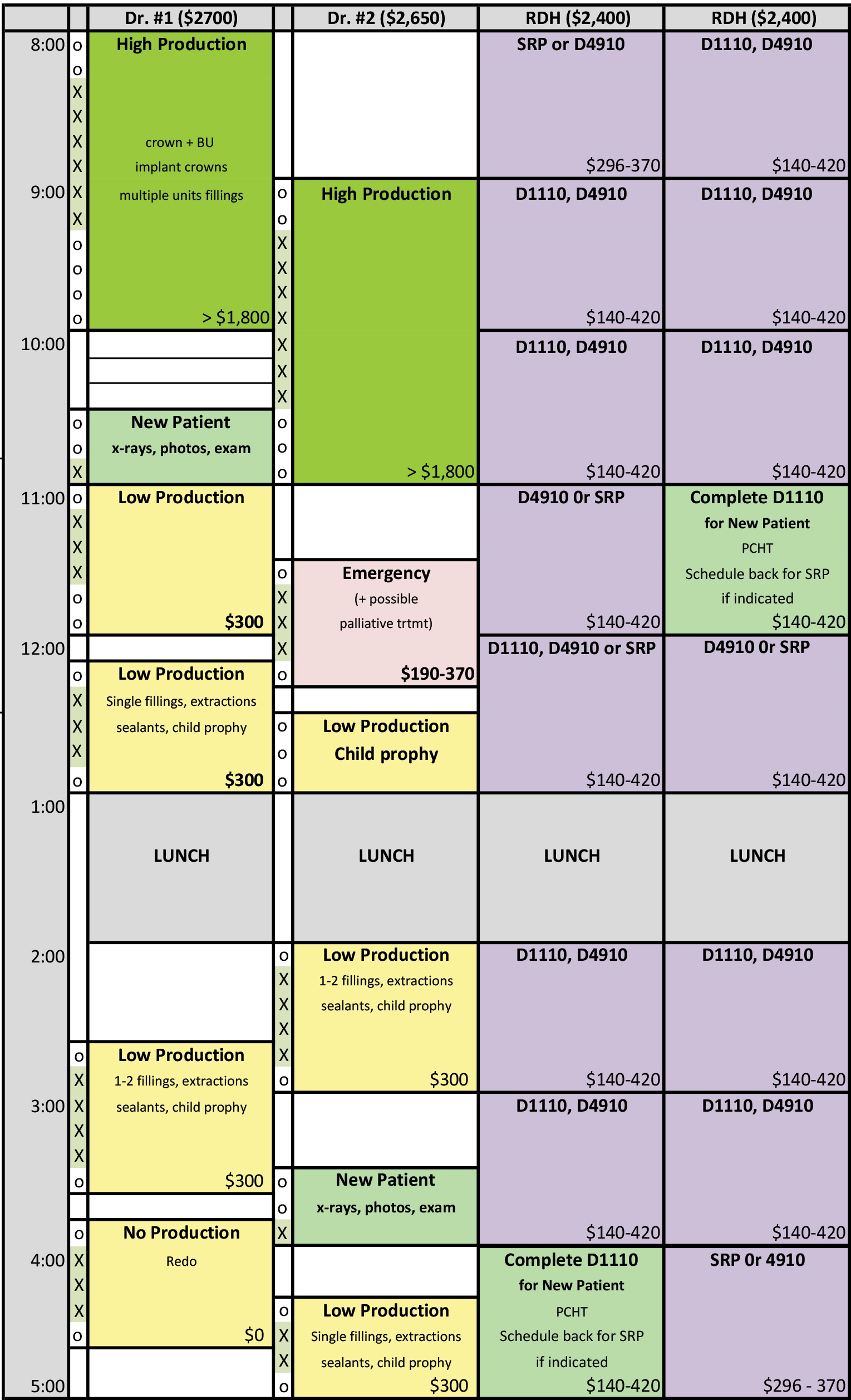Daily Scheduling Goals
Effective scheduling balances the patient flow while meeting daily production goals.

Determine your daily restorative and hygiene goals prior to building your schedule. Your daily goal can be calculated by dividing the annual goal by the number of days the practice is open, excluding holidays and vacations.
Ideally, 80% of your restorative production goal is met in the morning, with the remaining 20% in the afternoon.
Reserve time in the schedule for larger cases (2-hour restorative blocks), SRP, new patients, and emergencies. The number of large case blocks you need is determined by looking at your procedure coding report to gain historical data.
For example, if the doctor completed 192 crowns in a year – typically schedules 2-hours per crown – and the practice is open 192 days per year, you will need to block out one 2-hour block per day to support their crown diagnosis. Follow the same pattern to determine the number of other 2-hour blocks the schedule needs to support. Reserve SRP time in the hygiene schedule using the same historical data. Your zone schedule will be unique to your practice and reflect the doctor’s philosophy of care and time needed per procedure.
Constructing Your Schedule
Organize your days so longer, more productive treatment is scheduled in the morning.
Schedule hygiene SRP (periodontal therapy) appointments and periodontal maintenance visits (D4910) in the mornings when possible. Oftentimes, these patients don’t require exams, and therefore the doctor can focus on the restorative patient that is receiving more involved treatment. The doctor should have enough time to provide treatment with minimal distractions. This schedule is most effective when the doctor is willing to break for hygiene exams at a convenient time rather than waiting until the end of the hygiene procedure.
An exam completed in the middle of the procedure allows more time for the patient to ask questions and for the hygienist to support the doctor’s recommendation. This increases case acceptance and prevents time challenges when the hygienist needs the doctor just as they started restorative treatment or is taking a breather between patient care.
Morning-scheduled ‘rock’ (high production) restorative appointments |
Morning-scheduled high production hygiene appointments |
||
|---|---|---|---|
| Multiple unit crown and bridge | Implants | ||
| Quadrant dentistry | Sleep appliance treatment | ||
| Cosmetic procedures including orthodontic starts | New patients | ||
| Multiple units of composite/ resin | Periodontal therapy (4341 and 4342) | ||
| Endo | Periodontal maintenance (4910) |
Afternoon-scheduled ‘sand’ and ‘water’ (low production) restorative procedures |
Afternoon-scheduled ‘sand’ and ‘water’ (low production) hygiene procedures |
||
|---|---|---|---|
| Fillings | Recare appointments (1110) | ||
| Single unit crowns | Pedo prophies | ||
| Adjustments | Tissue checks | ||
| Emergencies (provide palliative treatment) | Sealants | ||
| Crown or veneer seats | Botox | ||
| Prosthetics delivery | |||
| Oral surgery | |||
| Consultations | |||
Patient Flow
When scheduled correctly, fewer patients are checking in and out in the morning, allowing the front office staff more uninterrupted time for accounts receivable and insurance follow-up, recare follow-up,confirmation calls and other tasks.
Because the hygiene schedule is usually scheduled 6 months ahead, work towards creating Zone Scheduling. Plan to hold your reserved restorative blocks of time for up to 3 days, releasing the block for other treatment in order to keep the schedule full.
Procedural Timing Reference
Successful zone scheduling accounts for time distributed between the doctor and dental assistant for the entire appointment, from the time the patient is seated to dismissed.
Dental assistants play a major role in maintaining an efficient patient flow throughout the day and provide services independent of the dentist to maximize patient flow. It is most effective to identify the time needed by the dental assistant in addition to the actual time the doctor expects to spend with the patient by procedure. This is crucial when utilizing 2 columns to schedule the doctor; overlap can be in place during assistant only time.
Practice Setting Up a Zone Schedule
The goal is to meet production goals without overextending the doctor and team.
- Fill in your own practice data to determine daily production goals and time blocks needed.
- In this example chart, the Doctor’s production goal was $5,200/day (480 recare exams = $4,720/year) and the Hygienist’s production goal was $2,400/day
- Consider your practices historical time needs. In this example, we accounted for ~1 ER per day, 25 new patients/month (~2 a day), 286 quads SRP/year (~6 per week), 2570 hygiene vistss/year (~54 per week), 44% high-fee procedures, 40% perio mix, and added hygiene hours for new patient growth.
- In this example, we also are setting new patient exams with pano at $312, no endo, $1,400 for average crown without BU, and B/U on ~54% of crowns priced at $1,684

Sample Schedule. X = Dr. time needed. O = Assistant time needed.
For more help constructing zone scheduling, download our Procedural Timing Reference.
Your success is our success. Please reach out to us anytime.
Learn more, visit the Practice Support Team page, email us at PracticeSupportTeam@BurkhartDental.com, or call 1.800.665.5323.
